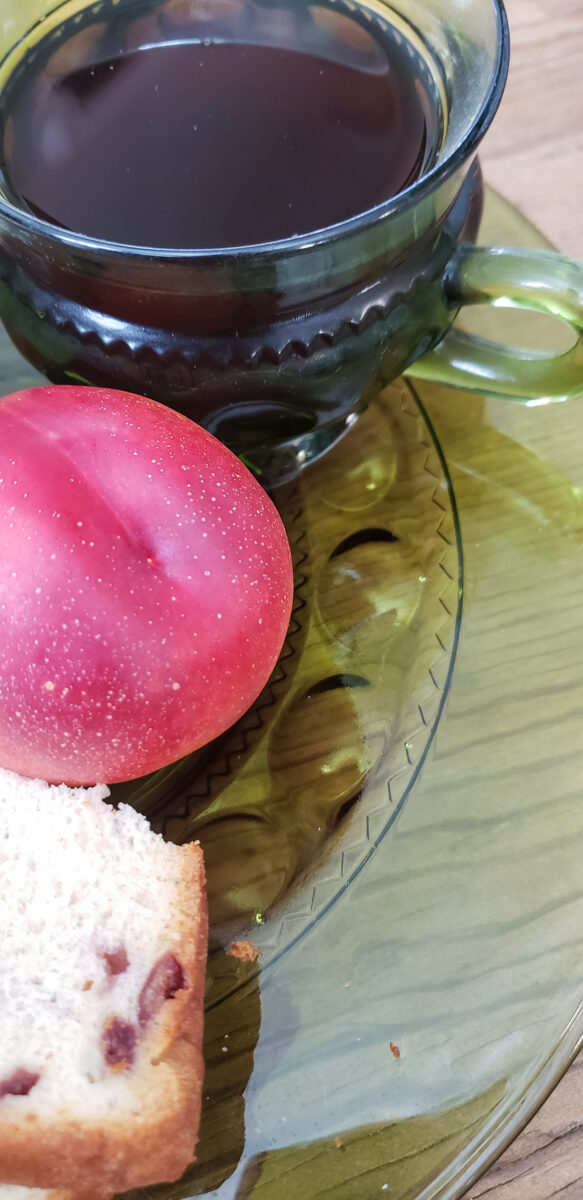 Did you see my post a few weeks ago sharing what Grand Millennial style is? In that post, we talked about the history of salt cellars, and shortly after that my dear friend Pegie gifted me a set of tiny salt cellar silver spoons that belonged to her mother! Her mother, Margaret, was my mother’s best friend so I am so happy to have Pegie and Margaret’s spoons in my collection now.
Did you see my post a few weeks ago sharing what Grand Millennial style is? In that post, we talked about the history of salt cellars, and shortly after that my dear friend Pegie gifted me a set of tiny salt cellar silver spoons that belonged to her mother! Her mother, Margaret, was my mother’s best friend so I am so happy to have Pegie and Margaret’s spoons in my collection now.
This time I’m sharing the history of the snack or “party” set which have become popular again by, you guessed it, grand millennials. What is a snack set? In simple terms, they are small-sized plates with circular indentations on one end for the accompanying small cup. Believed to have originated in Europe during the late 1800s, they were typically made of fine porcelain, then later were produced in clear, colored, milk and carnival glass. The popularity of the sets grew for use at afternoon teas and bridge parties from the 1920s through the 1940s, and by the 1950s snack sets were offered in boxes holding four, eight, or a dozen matching sets.
They are a charming size for a bridal or baby shower, a tea, or brunch when you wouldn’t normally eat a full-sized meal. They are easy to carry and don’t take up much room on a table. The cups are about 4-6 oz and perfect for punch and coffee.
I think they would also be fun for grazing a charcuterie board or dessert buffet. I am sharing three different sets I have and the ways you can use them.
This set is Kings Crown by Indiana Glass in avocado green produced by Indiana Glass Company in the late 1970s and 1980s. Originally issued as Thumbprint Line No. 4016 by US Glass in the late 1800s, this glassware was still being made by Tiffin Company in the early 1960s. Indiana Glass bought the Tiffin molds and changed the design somewhat.
Can you see the thumbprint border around the center of the plate?
 When I was growing up Mother had the same glassware in iced-tea and goblet size. Happily they reside with me now. I think Sister gifted me with this set. You can see I’m using it here for breakfast with toasting bread, yogurt, fruit and coffee.
When I was growing up Mother had the same glassware in iced-tea and goblet size. Happily they reside with me now. I think Sister gifted me with this set. You can see I’m using it here for breakfast with toasting bread, yogurt, fruit and coffee.
The next called Milk Glass belonged to mother. Milk glass, the nickname given to opaque white glass in a variety of patterns, was produced around the world for years prior to the mid-1800s when it became a commodity in the United States. Milk glass manufacturers in America were concentrated in Eastern Pennsylvania. The popularity of this glass piqued around 1895-1910, according to The Collector’s Encyclopedia of Milk Glass by Bill and Betty Newbound (now out of print but available through used booksellers), but Indiana Glass Company created a big milk glass revival in the 1940s and ’50s. Those pieces are the examples most often found by collectors today.
My milk glass plate and pedestal cups have a grape pattern. Mother gave me all her milk glass and I adore it. I have dinner plates, cups, glasses, and other fun pieces. I like to use the snack sets at Christmas and Valentine’s Day when the colors red and pink really pop with white. Here I am showing how you can use it as a dessert plate with icy cold milk.
My newest set came from a seller I follow on Instagram Inheritedit. It’s Blue Onion by Blue Danube. Mother started collecting this pattern and shared it with Sister. I was so excited to find a set of six snack plates. They are so tiny and delicate.
I am serving cold salads from the Hurley House called their “pool pack” from their summer menu. What you don’t see is the most delicious banana pudding I scarfed pretty soon after I got home. This is a good example of how you can pick up a salad pack from your favorite restaurant, set out your snack set, and enjoy a nice lunch among girlfriends with ease.
Just add a linen napkin and a cute set of faux bamboo stainless and you have a charm, vintage-inspired table sure to be memorable for everyone!






 Hospitality is in my DNA. I founded Home with a Twist, a daughter’s twist on her mother’s traditions, in memory of my mother to celebrate her life and the gifts she shared with me. Mother loved to celebrate life’s occasions – big and small.
Hospitality is in my DNA. I founded Home with a Twist, a daughter’s twist on her mother’s traditions, in memory of my mother to celebrate her life and the gifts she shared with me. Mother loved to celebrate life’s occasions – big and small.

Do you know who made Daisu Double Flower snack set? If so, do you have documentation?
I have maybe 20 sets of different luncheon place. Some have cups and some don’t . I started collecting them for lunch with you sisters and sister-in-laws. I did not know they where worth anymore then the few dollar’s l pad at a flea market or garage sale.